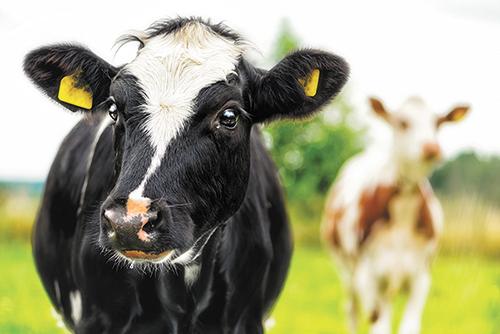From farm to food

Photo by Photo provided by thevegetarianmethod.com
Two cow calfs during a summer day. This image is from the food documentary Cowspiracy.
March 16, 2017
Before you decide to assign the title of “My Biggest Fear” to droughts, wildfires, melting ice caps, ocean acidification, entire countries going underwater, or any other climate change horror, consider first giving that lable to an even larger culprit of ozone layer damage: the cow. To clarify, I am not telling you to develop a seething hatred towards cows or scream profanities at them as you drive through the countryside — don’t kill the messengers. Old Bessie from the farm down the street has no control over the 400 liters of methane she gifts to earth’s atmosphere. More specifically, you should be focusing on those producing cattle and other farmed animals, at the macro level. The problem is not the cows, but the extent to which agriculturers produce and abuse these animals. According to the Cornell Chronicle and ecologists at Cornell, we are currently growing enough food to feed 10 billion people, 3 billion more than necessary.
I’d like to say it surprises me that a majority of the world values their ten-piece chicken nuggets over the fact that animal agriculture is the leading cause of species extinction, ocean dead zones, water pollution, and habitat destruction, but it doesn’t. Yes, humans are naturally omnivorous — not carnivores, not herbivores. We were made in a way that allows us to survive on whatever edible thing is accessible to us. Environmentalists cannot blame the average person for his or her ignorance towards the effects the animal and animal byproduct industries have on the declining health of the Earth’s environment. We live in a country, in a world, that begs us to consume by whatever means necessary. Because most leaders and corporations would much rather see a decline in the lifespan of the planet than that of the balance in their bank accounts, their customers (who constitute a majority of the population) are, willfully, oblivious to the reality of the planet’s environmental state.
The world needs mandated education regarding climate change. And, of course, even though it also takes a heart and common sense to get the job done, (that job being preventing the ultimate end of all things living) learning a thing or two about how to take care of the home humans and animals alike share is a good place to start. According to the Water Footprint Assessment, each day, a person who eats a vegan diet saves 1,100 gallons of water, 45 pounds of grain, 30 square feet of forested land, 20 pounds of carbon dioxide, and one animal’s life. If you can’t do it for the animals, do it for yourself, or, more importantly, the future of the entire planet.

